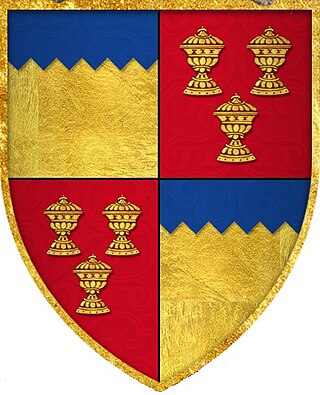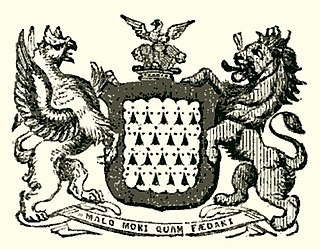Related Research Articles

Piers Butler, 8th Earl of Ormond, 1st Earl of Ossory also known as Red Piers, was from the Polestown branch of the Butler family of Ireland. In the succession crisis at the death of Thomas Butler, 7th Earl of Ormond he succeeded to the earldom as heir male, but lost the title in 1528 to Thomas Boleyn. He regained it after Boleyn's death in 1538.

Rowland FitzEustace, 1st Baron Portlester was an Irish peer, statesman and judge. He was one of the dominant political figures in late fifteenth-century Ireland, rivalled in influence probably only by his son-in-law Garret FitzGerald, the "Great" Earl of Kildare.
Christopher Plunket, 2nd Earl of Fingall and 11th Baron Killeen was an Irish politician and soldier. In 1641 he negotiated with the rebels on behalf of the Old English of the Pale and pushed them to join the rebellion. He fought for the rebels at the siege of Drogheda. He joined the Confederates and fought in their Leinster army, notably at Dungan's Hill. When the Confederates fused into the Royalist Alliance, he fought under James Butler, 1st Duke of Ormond in the Battle of Rathmines where he was wounded and taken prisoner. He died of his wounds two weeks later in captivity at Dublin Castle.
Maurice FitzThomas FitzGerald, 4th Earl of Kildare was a prominent Irish nobleman in the Peerage of Ireland who held the office of Lord Justice of Ireland.

John Barnewall, 3rd Baron Trimleston, was an Irish nobleman, judge and politician. He was the eldest son of Christopher Barnewall, 2nd Baron Trimlestown and his wife Elizabeth Plunket, daughter of Sir Thomas Fitz-Christopher Plunket of Rathmore, Lord Chief Justice of the King's Bench in Ireland and his second wife Marian Cruise. He succeeded his father as 3rd Baron about 1513. His father, like most of the Anglo-Irish aristocracy, had supported the claim of the pretender Lambert Simnel to the English throne in 1487. After the failure of Simnel's rebellion, he received a royal pardon.
Lucas More Plunket of Killeen, County Meath, styled Lucas Môr, tenth lord Killeen, created Earl of Fingall on 26 September 1628, was an Irish peer.
Robert St Lawrence, 3rd Baron Howth was a leading statesman in 15th-century Ireland who held the office of Lord Chancellor of Ireland. Through his second marriage, he was a close connection to the new Tudor dynasty, to which his son was staunchly loyal.
Nicholas St Lawrence, 4th Baron Howth was a leading Irish soldier and statesman of the early Tudor period, who held the office of Lord Chancellor of Ireland.
Sir Thomas FitzGerald of Laccagh (c.1458–1487) was an Irish lawyer, statesman and soldier who was Lord Chancellor of Ireland under Richard III and Henry VII, but rebelled against Henry and was killed at the Battle of Stoke.
Sir William Welles was an English-born statesman and judge in fifteenth-century Ireland, who held the office of Lord Chancellor of Ireland. He was the younger brother of Lionel de Welles, 6th Baron Welles. Lionel was a prominent supporter of the House of Lancaster, who was killed at the Battle of Towton on 29 March 1461.
Sir Robert FitzEustace (c.1420–1486) was an Irish landowner and politician of the fifteenth century.
Sir Thomas Cusack (1490–1571) was an Anglo-Irish judge and statesman of the sixteenth century, who held the offices of Master of the Rolls in Ireland, Lord Chancellor of Ireland, and Chancellor of the Exchequer of Ireland, and sat in the Irish House of Commons. He was one of the most trusted and dependable Crown servants of his time, although he led a somewhat turbulent private life.
Richard Delahide was an Irish judge of the sixteenth century, who held the offices of Chief Justice of the Irish Common Pleas and Chief Baron of the Irish Exchequer. His career was seriously damaged by the Rebellion of Silken Thomas, in which several members of his family played a leading part, and he was fortunate to escape permanent disgrace.
Baron Skryne was the title of the holder of an Irish feudal barony: the title derived from the parish of Skryne, or Skreen, in County Meath. It was not recognised as a barony in the Peerage of Ireland, but was habitually used firstly by the de Feypo family and then by their descendants, the Marwards. The Barons of Skryne were not entitled as of right to sit in the Irish House of Lords, although it seems that in practice the holder of the title was often summoned to the Irish Parliament. The title fell into disuse in the seventeenth century, when the family estates were forfeited to the English Crown. Thomas Marward, having been the last Baron of Skryne, died in 1568 without male inheritors.
Sir William Darcy (c.1460–1540) was a leading Anglo-Irish statesman of the Pale in the early sixteenth century; for many years he held the office of Vice-Treasurer of Ireland. He wrote an influential treatise, The Decay of Ireland, which led to his being called "the father of the movement for political reformation in Ireland". He was a colourful and flamboyant character, whose exceptional height gave rise to his nickname "Great Darcy".
The Brotherhood of Saint George was a short-lived military guild, which was founded in Dublin in 1474 for the defence of the English-held territory of the Pale. For a short time it was the only standing army maintained by the English Crown in Ireland. It was suppressed by King Henry VII in 1494, due to his suspicions about the Brotherhood's loyalty to his dynasty. It was not an order of knighthood, although some of its individual members were knights.
Sir Thomas Fitz-Christopher Plunket (c.1407-1471) was a leading Irish lawyer and judge of the fifteenth century who held office as Lord Chief Justice of Ireland. He was an ancestor of the Duke of Wellington in the female line. His second marriage to the heiress Marian Cruise inspired the ballad The Song of Mary Cruys.
Sir Thomas Plunket (c.1440–1519) was a wealthy Irish landowner, lawyer and judge in fifteenth-century and early sixteenth-century Ireland. He held office as Chief Baron of the Irish Exchequer and Chief Justice of the Irish Common Pleas. After the change of the English royal dynasty in 1485, his loyalty to the new Tudor dynasty was deeply suspect, and he was involved in two attempts to put a pretender on the English throne. On each occasion he was disgraced, fined and removed from office; yet he had sufficient political influence to ensure his return to favour and high office.
Sir Nicholas Barnewall was an Irish judge and landowner of the fifteenth century who held office as Lord Chief Justice of Ireland. He was the ancestor of the Barnewall Baronets of Crickstown.
Luke Plunket, 3rd Earl of Fingall (1639–1684) was an Irish soldier and politician. He was one of the signatories of the Catholic Remonstrance of 1661.
References
- ↑ O'Flanagan, J. Roderick Lives of the Lord Chancellors and Keepers of the Great Seal of Ireland 2 Volumes London 1870
- ↑ Ball, F Elrington The Judges in Ireland 1221-1921 John Murray London 1926
- ↑ Lodge, John and Archdall, Mervyn Peerage of Ireland Dublin 1789 Vol. 6 pp.187-8
- ↑ Ball Judges in Ireland
- ↑ Lodge and Archdall p.189